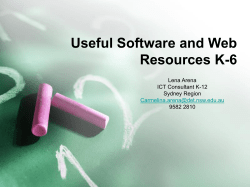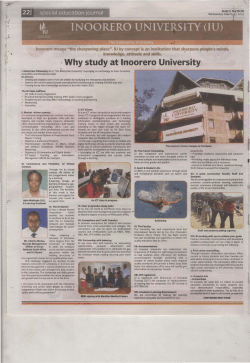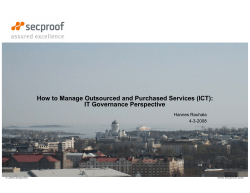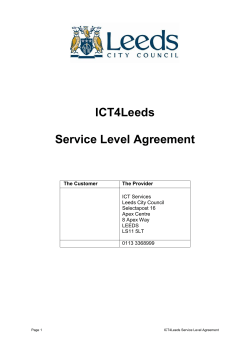
Sustainability-driven funding models for Green ICT investment case
Sustainability-driven funding models for Green ICT How to use carbon to support the investment case Innovation Dinner: GREEN IT 27 October 2011 Fritz Milosevic, with contributions from Jacoleen Simpson Off-Grid a reality, Carbon a reality • Off-grid locations pose an increasing challenge for Mobile Network Operator in the developing world. • Grid connectivity in many locations is either unavailable or unreliable. • An estimated 75,000 new off-grid sites will be built each year in developing countries through 2012. • Nearly 500m people worldwide have a mobile phone connection but no access to the electricity grid. • ICT sector contributes around 2% of global GHG emissions • Global carbon footprint of the ICT sector in 2002 was 0.5 GtCO2e*, emissions are forecasted to grow to 1.4 GtCO2e by 2020. Source: GSMA Development Fund, SMART 2020: enabling the low carbon economy in the information age, http://www.smart2020.org/ 2 * GtCO2e = metric gigaton of carbon dioxide equivalent Internet a major polluter 2007 electricity consumption, Billion kwH US 3923 China 3438 Russia 1023 Japan 925 Cloud computing 662 India 568 Germany 547 Canada 536 France 447 Brazil 404 UK 345 0 500 1000 1500 2000 2500 Source: http://www.greenpeace.org/international/Global/international/publications/climate/2011/Cool%20IT/dirty-data-reportgreenpeace.pdf 3 3000 3500 4000 4500 Estimated GHG Emissions of ICT Sector Explosive growth, a wide range of devices and energy sources, rapidly changing technology and business models makes it difficult to precisely establish the carbon footprint of ICT. 116 257 407 Access networks are the largest power consumer in a telco network. 358 Even more so in mobile 307 815 Computers and devices Computers and devices Telecoms and devices Telecoms and devices Data centres Data centres Source: http://www.greenpeace.org/international/Global/international/publications/climate/2011/Cool%20IT/dirty-data-reportgreenpeace.pdf 4 networks (Base stations). Leading operators are committed to CO2 reduction Examples 5 MTN Group is signatory to the Copenhagen Communiqué on Climate Change. Telefónica commits to reducing 30% its energy consumption in network by 2015 Tri-generation plant opened O2 Eco rating for handsets Reduce CO² emissions for Deutsche Telekom Group by 20% below 2006 levels by 2020 Reduce CO² emissions for FT Group by 20% below 2006 levels by 2020 Vodafones to cut own emissions by 50% by 2020 (from the 2006/07 baseline). Reduce UK CO² emissions in absolute terms by 80% below 1996 levels, by December 2016 Focus areas in the “green” consideration Three key areas emerge as important in the discussion around renewable energy and sustainability for Operators – Base Stations, Data Centres and Handset Charging. „Green“ focus areas for operators and major reasons for consideration 1. Base Stations 6 2. Data Centres 3. Handset Charging Opex reduction Opex reduction Usage increase Energy efficiency Energy efficiency ARPU increase Power supply independance Power supply independance Social sustainability Business continuity Business continuity Carbon footprint reduction Carbon footprint reduction Carbon footprint reduction Indicative financial impact ICCP for MNO (example) Indicative Delta Case Financials (USDm) Income Statement Total Revenue Snyman + ICCP % Increase in Revenue EBITDA Snyman + ICCP % Increase in EBITDA Reported net profit Snyman Reported net profit Snyman & ICCP % Increase in net profit Cash Flow Statement Net Cash impact Y/Y FCF Growth without ICCP Y/Y FCF Growth with ICCP Delta in FCF growth • Significant impact on Net Profit and Free Cash Flow • Shareholder value increase Source: Company data and NedSec 7 2011 2012 2013 1,219 0.5% 547 1.8% 265 272 2.6% 1,353 1.4% 615 5.2% 316 338 7.0% 1,488 2.1% 688 8.8% 376 417 11.0% 2.5 98.0% 100.8% 2.8% 10.8 23.5% 26.9% 3.4% 26.1 19.6% 24.2% 4.6% ICT is becoming serious about “green & clean” ICT companies as clean tech investors Example Google DC’s and RE Who would have imagined 5 years ago Google and IBM would be leading clean tech investors, involved in Solar, Geothermal or Energy Storage? The 2010 Global Cleantech 100: Corporations that are a stakeholder in two or more Corporation HQs No. of engagements Google USA 6 IBM USA 6 Landis+Gyr Switzerland 6 PG&E USA 6 Source: Global Cleantech 100, A Barometer of the Changing Face of Global Cleantech Innovation, Cleantech Group; Google 8 The Investment Universe and “Sustainability” Trends Globally From 1999 to 2010, the number of sustainability indices being offered by members of the World Federation of Exchanges increased from 2 to more than 50 As of July 2011, the Carbon Disclosure Project has 551 financial institutions as signatories with US$71 trillion AUM, worldwide According to Eurosif (European Sustainable Investment Forum), as of 7 December 2010, sustainable investment in emerging markets topped $300bn Global evidence for indices based on carbon and climate change awareness outperforming the market: According to PwC, companies in both the Carbon Disclosure Leadership Index and the Carbon Performance Leadership Index generated approximately double the average total return of the Global 500 Index (between Jan 2005 and May 2011). Trends South Africa In the latest report on emerging markets, Eurosif has identified South Africa as a preeminent destination for sustainable investment, with transparent reporting and above average integration of social issues. Such a perception can only be enhanced by companies adopting the King III injunction to produce integrated annual reports As of July 2011, there are 26 local asset managers who are signatories to the United Nations Principles of Responsible Investment Nedbank Capital launched South Africa‟s first Green Index in 2011 Environmental sustainability is increasingly prominent and mainstream amongst global and South African investors. 9 International climate funds – an option? • Climate funds designed to support low-carbon and climate-resilient development through scaled-up financing • Over 200 Climate Funds – e.g. GEF, Forest Carbon Partnership Facility, Clean Technology Fund , etc • Mainly multi/bilateral funds, channelled through multilateral institutions/ DFI‟s such as IFC, World Bank, African Development Bank, etc. • Important discussion at COP17: the Green Climate Fund (GCF), channeling USD 100bn p.a. from developed to developing countries by 2020. • Derived “nationally appropriate mitigation actions” (NAMA‟s) will direct climate finance to projects that mitigate greenhouse gases • Private sector facility and participation still open – point of tense discussions Source: http://www.climatefundsupdate.org/ 10 What can ICT companies do to lower the carbon footprint and use carbon to compliment funding? • energy efficiency measures, demand side management • Renewable energy usage • carbon off-setting • carbon credit programmes for Base Stations, Data Centre‟s, etc • programmatic Micro-Carbon-Credit programmes for handset charging with innovative renewable solutions • Nedbank Capital offers holistic, innovative financial solutions addressing the needs of operators/ ICT providers and consumers by adding value to their ambition to overcome the off-grid challenge and reduce CO2. 11 Highlight’s of Nedbank’s green credentials • 13 July 2010 we have achieved carbon neutrality the first financial services organisation in Africa to achieve this. • By following the 'reduce first and offset only what we have to' approach, Nedbank has added real credibility to its carbon neutral status. • Underwriter of world's first REDD project (Rukinga, Kenya) • Our new office block in Sandton, South Africa, is SA's first Green Star-rated building. A „green‟ building is one that has achieved a Green Star rating from the Green Building Council of South Africa. • Nedbank Capital launched South Africa‟s first Green Index in 2011 12 Thank You! Contact details Nedbank Capital F block 135 Rivonia road Sandown 2196 South Africa Contact Position Office Mobile Email Fritz Milosevic Investment Banker Telecommunication +27 11 294 1755 +27 82 902 9740 fritzm@nedbankcapital.co.za High Level Overview Carbon Credits Nedbank Capital aims to remove the need for telecom operators to have to deal with the complexities of the compliance and voluntary carbon markets. The operator can focus on his core business: revenue generation. Carbon credits The Clean Development Mechanism (CDM) as well as voluntary labels allow for Green House Gas emissions reductions to be realised. Emissions reductions The small scale CDM allows for 0.8 to 1.4 kgs of CO2 per reduced kilowatt hour of diesel generation (depending on load factors). Therefore a Megawatt hour of diesel powered reduction would reduce between 800 and 1400kgs of CO2 worth approximately Euro 12 to 20. Reductions of diesel usage replaced by renewable energy would constitute a project. Methods exists for counting the emissions reductions of such projects. Regulators The UN Framework Convention on Climate Change CDM Executive Board oversees the compliance market related to the Kyoto Protocol. The Gold Standard (GS) deals with compliance and voluntary markets. The Gold Standard is a high quality standard looking to maximise sustainable development and attracts a premium in both markets. To obtain credits compliance with regulators is required. Transaction costs All methods for the realisation of credits have transaction costs associated with them. The smaller the scale the lower the transaction costs (which favours GS Voluntary for telecom operators). Project/programme participants must check the feasibility of credits versus transaction costs. Source: Energy Transformation 15
© Copyright 2025





















